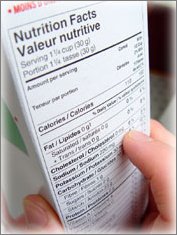What Exactly Does it Mean When Foods are Hydrogenated, and What Risks Can it Pose?
by www.SixWise.com
Hydrogenation is a chemical reaction -- widely used in the
processing of cooking oils and fats -- that turns unsaturated
fatty acids into saturated ones. Technically speaking, during
this process unsaturated bonds between carbon atoms are reduced
by attaching a hydrogen atom to each carbon. Simply speaking,
hydrogenation is a process in which hydrogen atoms are added
to vegetable oils.
|

Aside from margarine and vegetable shortening, partially
hydrogenated oils are commonly found in crackers, cookies,
baked goods, salad dressings, bread and more.
|
When the process is not carried out completely (which is
common in industry) the ending product is described as being
"partially hydrogenated."
According to Udo Erasmus, author of "Fats
That Heal, Fats That Kill" "So many different
compounds can be made during partial hydrogenation that they
stagger the imagination. Scientists have barely scratched
the surface of studying changes induced in fats and oils by
partial hydrogenation."
Why are Foods Hydrogenated?
The French chemist Paul Sabatier discovered the hydrogenation
process back in 1897. However, it wasn't until W. Normann,
an Englishman, received a patent in 1903 for the hydrogenation
of liquid oils using hydrogen gas that the process became
part of industry worldwide.
When a food is hydrogenated, its molecular shape changes,
making it more solid and rigid. An oil, for instance, that
is hydrogenated will become solid, even at room temperature
(such as hard margarine or shortening).
There are two major reasons why foods are hydrogenated, and
they both boil down to dollars and cents:
Food manufacturers, therefore, love to use hydrogenated oils
and fats because their foods stay fresh and good-tasting much
longer than any natural food ever could.
The Big Problem
"Hydrogenation, which is used to turn oils into margarine,
shortening, or partially hydrogenated vegetable oil, produces
trans-fatty acids, which are twisted molecules. Twisted, their
shape changes, and they lose their health benefits and acquire
toxicity instead," says Erasmus.
The creation of trans
fats is the major, and until recently overlooked, health
risk of eating hydrogenated foods. In fact, major may be an
understatement.
So toxic are these fats that the National Academy of Sciences'
Institute of Medicine said that trans fats shouldn't be consumed
at all. The Food and Drug Administration says that intake
should be as low as possible.
Yet, unknowingly, some Americans eat 30 to 40 grams of trans
fat daily.
According to the Harvard School of Public Health, trans fats:
-
Double the risk of heart attack
-
Are responsible for the deaths of 30,000 Americans every
year
-
Increase the risk of diabetes
Other research has shown that trans fats:
-
Raise your body's level of bad cholesterol (LDL) while
lowering the good cholesterol (HDL)
|

As of January 1, 2006, you can now find out if
trans fats are in your food by reading the nutrition
label. This is the first time in history trans fats
have been required on the labels.
|
-
Increase triglycerides and inflammation
-
Interfere with vision in children
-
Hinder liver detoxification
-
Correlate with increased prostate and breast cancers
-
Impede insulin function
-
Interfere with reproduction in animals
Trans fats are found in a wide range of processed foods from
the obvious (fried foods, margarine, baked goods, vegetable
shortening) to the unexpected (bread, cookies, snack crackers,
salad dressings, granola bars, cereals, frozen dinners and
much, much more).
In fact, trans fats can be found in 40 percent of all processed
foods in supermarkets today.
The Good News
As of January 1, 2006, new FDA regulations require food manufacturers
to list trans fats on food
nutrition labels (directly under the line for saturated
fat). So, as a consumer, you can now avoid trans fats much
more easily, just by reading nutrition labels. If you also
read ingredient lists, terms to watch out for include anything
that says hydrogenated or partially hydrogenated, along with
vegetable shortening or margarine, which may also be hydrogenated.
Recommended Reading
Trans
Fat's Strong Link to Cancer, Diabetes & Heart Disease,
and How to Avoid It
All
the Health Risks of Processed Foods -- In Just a Few Quick,
Convenient Bites
Sources
Trans
Fats: The Science and the Risks
UdoErasmus.com
Hydrogenation
and Margarine